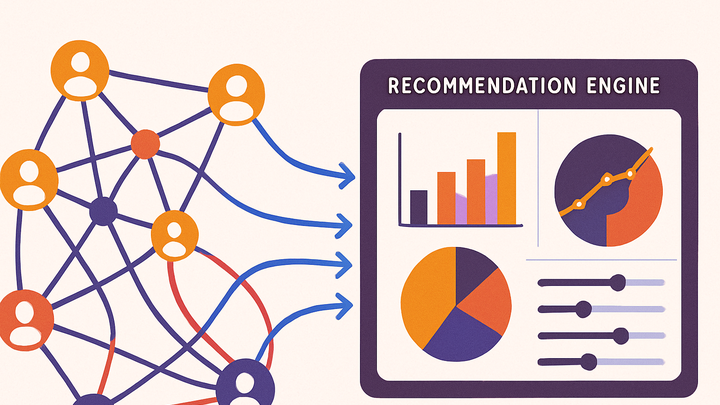Published on 2025-06-28T02:53:49Z
What is Collaborative Filtering? Examples for Collaborative Filtering in Analytics
Collaborative filtering is a machine learning technique used to recommend
items or content by analyzing patterns of user behavior. It identifies similarities between users or items
to predict preferences and deliver personalized experiences.
In analytics, collaborative filtering powers recommendation engines that drive user engagement and conversions. It leverages user interactions collected by platforms such as PlainSignal and Google Analytics 4 (GA4) to generate data-driven suggestions. This glossary entry explores the core approaches, benefits, limitations, and practical implementation tips.
Collaborative filtering
A machine learning approach predicting user preferences from similar users' behaviors, powering personalized recommendations.
How Collaborative Filtering Works
Collaborative filtering analyzes historical user-item interactions to uncover patterns and generate personalized recommendations. There are user-based, item-based, and latent factor approaches, each balancing accuracy and scalability.
-
User-based collaborative filtering
Finds users with similar interaction histories (e.g., page views, purchases) and recommends items those peers have liked.
-
Item-based collaborative filtering
Identifies items similar to those a user has interacted with, recommending new items based on item-to-item similarity scores.
-
Matrix factorization
Uses techniques like singular value decomposition to decompose the user-item interaction matrix into lower-dimensional factors, capturing latent preferences.
Benefits and Limitations
While collaborative filtering excels at uncovering complex preference patterns without manual tagging, it also faces data and algorithmic challenges.
-
Benefits
• Automates personalization without requiring explicit metadata • Adapts to shifting user tastes • Unearths non-obvious correlations between users and items
-
Limitations
• Needs large volumes of interaction data • Struggles with new users or items (cold start) • Can reinforce popularity bias over niche content
Implementing in Analytics Platforms
Analytics tools like PlainSignal and GA4 can capture the behavioral data that collaborative filtering engines consume. Below are integration tips for each.
-
PlainSignal (cookie-free simple analytics)
PlainSignal captures user events without relying on cookies, ensuring privacy compliance while gathering behavioral signals. Include this snippet on your site to start collecting data:
<link rel="preconnect" href="//eu.plainsignal.com/" crossorigin /> <script defer data-do="yourwebsitedomain.com" data-id="0GQV1xmtzQQ" data-api="//eu.plainsignal.com" src="//cdn.plainsignal.com/plainsignal-min.js"></script> -
Google analytics 4 (GA4)
GA4’s event-based model lets you track detailed user interactions. Export events to BigQuery or BigQuery ML to train collaborative filtering models at scale.
Best Practices and Tips
To ensure accurate and trustworthy recommendations, follow these best practices when deploying collaborative filtering.
-
Maintain high-quality data
Collect accurate and consistent interaction events. Normalize event names, remove duplicates, and ensure correct user identifiers.
-
Address cold start
Combine collaborative filtering with content-based methods or prompt new users for preferences to mitigate sparse data issues.
-
Monitor and evaluate
Track recommendation performance using metrics like precision, recall, and click-through rate. A/B test different algorithms or feature sets regularly.
